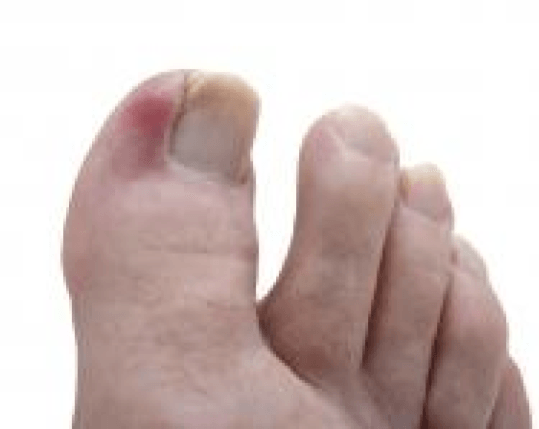Ingrown Toenail
What is Ingrown Toenail?
An ingrown toenail is a common and painful condition of the toe that occurs when the sides or corner of the nail grows inward and penetrates the skin of the toe. The big toe is most often affected.
Anatomy
The nail is composed of a nail plate, nail matrix and nail bed. The nail matrix is the region where the nail cells form and multiply to form the nail. It starts below the fold of skin called the cuticle, where the skin of the finger or toe meets the nail. The nail is called the nail plate and the nail bed is the soft tissue underlying the nail that anchors it in place.
Causes of Ingrown Toenail
Ingrown toenails occur most often by wearing tight shoes, having unusually curved nails that grow downward, or trimming your nails very short or curved.
Symptoms of Ingrown Toenail
Pain is often accompanied by swelling and redness. Other symptoms may include tenderness, fluid build-up, bleeding and oozing pus. The skin may become hard or grow over the toe.
Diagnosis of Ingrown Toenail
An ingrown toenail is usually diagnosed by a physical examination. An X-ray may be ordered to determine the extent of growth of the nail into the skin, and if the condition is caused by injury.
If Untreated
Untreated ingrown nails can lead to infection or even an abscess that necessitates surgical treatment. The underlying bone can become infected and cause a severe bone infection. The condition becomes even more severe if you have diabetes. Immediate attention is required to avoid decay and death of tissue (gangrene).
Treatment of Ingrown Toenail
Ingrown toenails should be treated by your doctor, especially if you suffer from diabetes. Your doctor may suggest soaking your foot regularly in warm water, prescribe antibiotics and pain relievers, and suggest wearing open-toed shoes or sandals.
Matricectomy is a technique of removing all or part of the base nail portion (nail bed) using chemical, electrical or surgical methods.
Procedure
An anaesthetic is injected into your toe and your doctor cuts away the ingrowth, ensuring that the nail bed is not disturbed.
Post-Operation
After surgery, your toe will be wrapped in a bandage and you will be advised to keep your foot raised and wear soft open-toed shoes for a few days. Pain medication will be prescribed to keep you comfortable. Following a total nail removal, you will have an indentation in the place of your nail.
Downtime
Following the removal of the toenail, it may take 3-4 months for the regrowth of a new nail.
Outcome
Surgery is successful in the recurrence of ingrown toenails. The complete removal of the nail further reduces your chances of recurrence.
Prognosis of Ingrown Toenail
Most ingrown toenails are harmless and improve within a week with just conservative home care measures.
There are chances that the toenail can grow back into the skin even after treatment. Therefore, permanent removal of the nail may be advised, especially in children suffering from chronic, recurrent infected ingrown nails.
Prevention of Ingrown Toenail
You can prevent the formation of ingrown toenails by following these measures:
- Trim your nails straight across instead of curved towards the edges.
- Keep your feet clean, dry and moisturised.
- Use a pumice stone or foot file to remove hard dead skin.
- Wear well-fitting shoes that are not tight and pointed toward the tip.
- Change your socks regularly.


